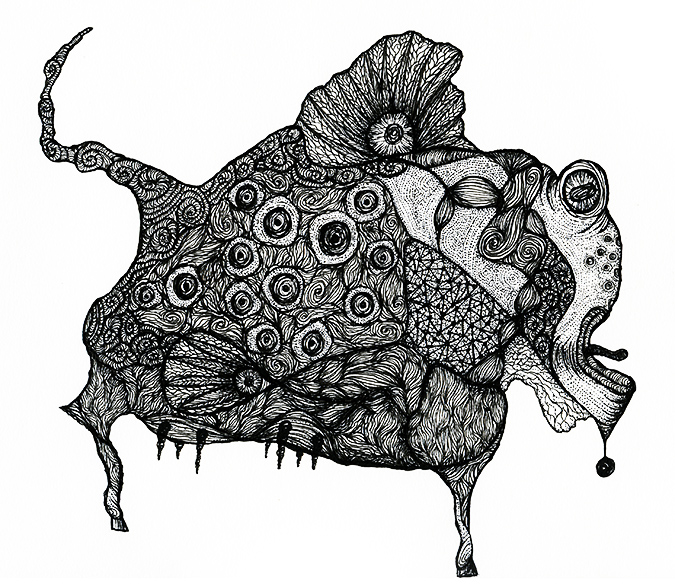The Wilterkindë
Wilterkindë (petrasus dynatogambium) (rock hog strong hoof)
The petrasus dynatogambium is a creature which has existed unverified by science until recent times. It has, however, haunted the mind of man as long as he has walked and thought. In Europe it is known as the Wilterkindë. It is this name that accompanied its official scientific description in 1871, and has been used widely ever since. Some have hypothesized that the Japanese folk monster, Minakami Bōto, and the Russian Ryba Svin’ya are in fact a variety of the same animal. In any case, creatures matching the description of the Wilterkindë have featured in numerous folktales around the world. One notable example is the following excerpt from the Germanic epic verse, Tod in einer Winternacht (Death on a Winter Night):
At long past light obscured
The Night had thought it saw
A log that writhed in flames
And an idol rising from the pit
A face with faces staring
And the Night knows Night is potent
When the New Moon walks the earth
With veil-clad features
Stalking in disguise
The tenderest of her children
Asleep, Awake, Alive
And the Night knows Night is potent
When the winter prolongs her domain
Born from icy opal drifts
Woken with howling canine echoes
The Wilterkindë comes.
The creature had until relatively recently remained in the realm of cautionary tales to frighten children on a cold winter day. However, in 1871, Casimer Herzog, a German naturalist, whilst out on a research expedition in the Black Forest, became lost in the woods all night. Towards dawn, he heard a strange cry belonging to no animal he could identify. Being a curious man, he forgot his fatigue and followed the noise until he came upon an injured Wilterkindë trapped in a ravine. The specimen had a compound fracture to the hind leg and was unable to climb out of the ravine. Upon catching sight of Herzog, the creature became so frightened and enraged that it dashed its own brains out against the rocks trying to escape. Herzog brought back a team of strong men to haul the creature out and took it back to his lab. Herzog had never seen anything resembling the Wilterkindë, but he immediately recognized it from the tales his grandmother had told him as a boy.
Herzog was able to fully describe the physical appearance of the Wilterkindë and created many drawings of the creature which he deemed most delightful despite its obstreperousness. See his most famous and detailed drawing below.

As you can see, the Wilterkindë moves around on four legs like any reasonable mammal, however the normalcy ends there. The specimen he found weighs upwards of 500 pounds, but is believed to have been but a juvenile, with observed adults being found to weight up to a ton. It has split hooves, which, being both sharp and hard, may be used to deliver a fatal blow to most creatures it might encounter. It has a combination of scales, fur, and bare skin on different parts of its body. The tale and back are covered in hard armor-like scales similar to that of the armadillo, which may be various shades of orange and red. The underbelly and legs are protected by thick and course ginger hair matted into an impenetrable mesh, which falls off as a new layer grows in underneath. The sides are covered in red, blue, and purple scales in a pattern which creates an eye spot effect similar to that which is used by insects. This is thought to be a remnant of when the Wilterkindë coexisted with dinosaurs, as they have no known modern predators which they would need to frighten away. The back of the Wilterkindë has a fan-like crest, which folds and unfolds, the purpose of which is dual: to cool the creature’s blood as it runs through the web of capillaries close to the surface of the semitransparent fan and as a signal of acquiescence culminating a successful mating ritual. The Wilterkindë also has a blue wattle running from the chest to the chin, which is an indication to a mate of good health if the color is vibrant. There is a wholly unique and interesting feature in close proximity to the wattle. It is a dangling bulbous bit of flesh containing a pungent packet of the animal’s scent. It is used to mark the Wilterkindë’s territory. As it patrols, which it does most frequently, it smacks this ball against a tree or rock until it falls off, leaving its odor there for up to a year. The ball then grows back within a week. The Wilterkindë has large eyes with horizontally elongated pupils like that of a goat placed on either side of its head, which give it an almost 360˚ range of vision. The skin of the face is bare and is of a ruddy hue. Notably, it has 16 nostrils, each of which specializes in a range of scent, giving it unparalleled scent detection.
The Wilterkindë is a nocturnal animal, which hides in areas of dense brush or in caves when available throughout the day. It was the animal’s cry of alarm at being exposed in the dawn light that Herzog was able to follow. The cry itself is quite curious as it emanates from a small hole in the creature’s right flank, the mechanism of which is much too complicated outside an advanced anatomy course.
The Wilterkindë was also found by Herzog to be hermaphroditic with the ability both to mate with another of its kind and to self-impregnate. Being solitary creatures with wide ranges of territory, they rarely meet another of their kind, so this enables them to procreate if a suitable partner can’t be found within the right time frame. The Wilterkindë must mate so that it may lay its egg or the egg will be crushed and reabsorbed by the parent body, a process accompanied by muscle cramping and spasms. Despite the apparent convenience of self-impregnation, the Wilterkindë prefers to mate with a partner because it is far more pleasurable, though it, of course, means they must go through the complex and dangerous mating rituals they have become famous for.
The mating ritual of the Wilterkindë is fascinating due to humankind’s perverse desire for revulsion. When the time draws near for the Wilterkindë to lay its egg, it becomes increasingly distressed, and calls out repeatedly with its unique voice. Their egg cycles are always on the same schedule, following the fazes of the moon. If a potential mate is in close enough proximity, which may be up to several thousands of miles away, it will call back, and they will find each other with sound and scent. When they catch sight of one another, they will immediately defecate a large amount of extremely pungent feces of sludge-like consistency, which they store in a special chamber of their colons for this purpose. They will go to the other individual’s defecation and taste it to acquire clues to their nutrition. If it is found favorable, they will roll in the feces and then immediately begin to attack each other. They use their sharp hooves and direct them at the other’s wattle, which is the most sensitive area of the Wilterkindë’s tough body. They will spar until, by some unknown signal, bloodied and weakened, they will raise their crests to signal the intention to mate. They will approach one another and start to shake all over, secreting a milky, viscous substance from their skin called procreative substrate. No one has been able to discover where such a large quantity of this substance is stored in the body of the Wilterkindë, but some hypothesize that it is produced though some kind of chemical reaction wherein a small amount of some chemical is secreted and then expands when it becomes oxidized. That theory remains unproven, however, and has been propounded by those on the fringe of scientific thought. The procreative substrate engulfs both individuals as they rear up on hind legs, press their chests together and become fused in that position for the duration of the mating, which will last as long as a week. The procreative substrate hardens around the pair, forming an opaque protective cocoon. A passageway opens between the two chest walls allowing a packet of DNA to pass from each individual to the other. Mating pairs may be studied through ultrasound and recording devices. With these methods, it has been determined that this process is both painful and pleasurable for the Wilterkindë. They can be observed to make ecstatic cries and convulse in orgasmic spasms repeatedly throughout the process. Once the transfer is complete a scab will form between the openings in their chests, and the pair will secrete a substance called procreative substrate negation fluid, which will cause the cocoon to dissolve. Once the remains of the procreative substrate dissolves they will pull apart, lick each other clean to reabsorbed lost nutrients, and, in a much weakened state, leave to find a suitable place to lay their eggs. They find a small pond or other waterway where the egg, which will weigh approximately 65 pounds, can be fully submerged. This is a necessity, as the Wilterkindë young can only breathe with gills for the first 6 months of life. Similar to a Kiwi, the process of laying eggs is unpleasant for the Wilterkindë. It can take some time to push out the large egg, and the process may even cause some tearing to the cloaca. Once the egg has been laid, the exhausted Wilterkindë rests for several days, then, having lost as much as 100 pounds will eat heartily to replenish its stores. Luckily, the need to lay an egg only occurs approximately every 23 moon cycles.
Herzog’s specimen was found to have primarily subsisted off of the Giant Earthworm (lumbricus badensis), due most probably to the convenience of that food to its habitat, the Black Forest. The Wilterkindë has a stomach that can adapt to most types of food, including tough plants indigestible to most animals, thanks to a wide variety of enzymes cultivated in their 6 stomachs. Though, they only resort to nutrient-poor foods when they have no other choice. They are opportunists, but they have their preferences, specifically carnivorous preferences. They most enjoy tender hairless animals such as small human children, but they cannot get them often enough to be considered a nuisance to society, as their main objective has been historically to avoid human-kind as much as possible. It is for this reason, that they were viewed as a myth for so long.
With their bright markings and massive bodies, it may be hard to believe they could be elusive. The However, the Wilterkindë has one more secret weapon: a gland at the end of its spiny tail, which can spray a hallucinogenic substance forward into the face of an adversary. This substance can be found nowhere else in nature and is currently being studied for its medicinal properties. The victim of this hallucinogen will experience severe delusions lasting as little as a few weeks to as long as a few years. This enables the Wilterkindë to escape from its disoriented victim and causes any witnesses to thereafter be deemed wholly unreliable. We may study them in modern times whilst wearing gas masks for protection. Herzog escaped being sprayed by his specimen due to the fact that the sharp end of its tale had become lodged in its flank as it fell, an incident most unfortunate for the specimen Herzog fondly named Knuddelmuddel, but fortunate for science and mankind that we might understand this amazing creature better.
